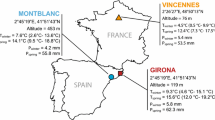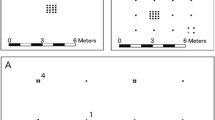Summary
Apterous parthenogentic females of the pea aphid,Acyrthosiphon pisum (Harris), begin to produce alate offspring soon after they have been subjected to crowding.
Females which were born early in their own parent's reproductive period respond most strongly to crowding, producing much larger numbers of alatae than their late-born sisters.
In contrast, the early-born daughters of most alate females do not produce winged offspring after being crowded. Some of their later-born sisters may produce a few winged individuals, resembling in this respect the late-born daughters of the apterous females.
Control of the production of alatae thus begins in the grandparental generation. Risk-spreading by means of differential dispersal becomes a less uncertain venture when local populations can modify their responses to environmental changes by utilizing past as well as present signals from their surroundings.
Similar content being viewed by others

References
Baltensweiler, W. (1970) The relevance of changes in the composition of larch bud moth populations for the dynamics of its numbers.Proc. Adv. Study Inst. Dynamics Numbers Popul. (Oosterbeek, 1970), 208–219.
Boer, P. J. Den (1968) Spreading of risk and stabilization of animal numbers.Acta biotheor.18: 165–194.
Bonnemaison, L. (1951) Contribution à l'étude des facteur provoquant l'apparition des formes aitées et sexuée chez les Aphidinae.Ann. Epiphyt. (C)2: 1–380.
Chitty, D. (1960) Population processes in the vole and their relevance to general theory.Can. J. Zool.38: 99–113.
Emden, H. F. van, V. F. Eastop, R. D. Hughes, andM. J. Way (1969) The ecology ofMyzus persicae.Annu. Rev. Entomol.14: 197–270.
Gruys, P. (1970) Growth inBupalus piniarius (Lepidoptera: Geometridae) in relation to larval population density.Research Inst. for Nature Manag., Verhandelingen no. 1, 127 pp.
Howe, R. W. (1967) The influence of the age of the parents on some characteristics of the offspring of insects bred in the laboratory.J. stored Prod. Res.3: 371–385.
Hughes, R. D. (1963) Population dynamics of the cabbage aphidBrevicoryne brassicae L.J. Anim. Ecol.32: 393–424.
Johnson, B. (1957) Studies on the degeneration of the flight muscles of alate aphids. I. A comparative study of the occurrences of muscle breakdown in relation to reproduction in several species.J. Insect Physiol.1: 248–266.
Johnson, B. (1959) Effect of parasitization byAphidius platensis Brèthes on the developmental physiology of its hostAphis craccivora Koch.Entomol. exp. appl.2: 82–99.
Johnson, B. (1965) Wing polymorphism in aphids. II. Interaction between aphids.Entomol. exp. appl.8: 49–64.
Johnson, B. (1966) Wing polymorphism in aphids. III. The influence of the host plant.Entomol. exp. appl.9: 213–222.
Johnson, B. andP. R. Birks (1960) Studies on wing polymorphism in aphids. I. The developmental process involved in the production of the different forms.Entomol. exp. appl.3: 327–339.
Kennedy, J. S. (1961) Continuous polymorphism in locusts.Symp. roy. entomol. Soc. Lond.1: 80–90.
Kennedy, J. S. andH. L. G. Stroyan (1959) Biology of Aphids.Annu. Rev. Entomol.4: 139–160.
Leckstein, P. M. andM. Llewellyn (1975) Corpus allatum activity and wing determination inMegoura viciae.Nature258: 714–715.
Lees, A. D. (1961) Clonal polymorphism in aphids.Symp. roy. entomol. Soc. Lond.1: 68–79.
Lees, A. D. (1966) The control of polymorphism in aphids.Adv. Insect Physiol.3: 207–277.
Lees, A. D. (1967) The production of the apterous and alate forms in the aphidMegoura viciae Buckton, with special reference to the role of crowding.J. Insect Physiol.13: 289–318.
MacKay, Patricia A. (1974) Studies of maternal age as a source of variation in two insect species. Ph. D. Thesis, University of British Columbia, Vancouver.
Mackay, P. A. andW. G. Wellington (1975) A comparison of the reproductive patterns of apterous and alate virginoparousAcyrthosiphon pisum (Homoptera: Aphididae)Can. Ent.107: 1161–1166.
Murai, M. andK. Kiritani (1970) Influence of parental age upon the offspring in the green rice leafhopper,Nephotettix cincticeps Uhler (Hemiptera: Deltocephalidae).Appl. Entomol. Zool.5: 189–201.
Shaw, M. J. P. (1970a) effects of population density on alienicolae ofAphis fabae Scop. II. The effect of crowding on the expression of migratory urge among alatae in the laboratory.Ann. appl. Biol.65: 197–203.
Shaw, M. J. P. (1970b) Effects of population density on alienicolae ofAphis fabae Scop. III. The effect of isolation on the development of form and behaviour of alatae in a laboratory clone.Ann. Appl. Biol.65: 205–212.
Shaw, M. J. P. (1973a) Effects of population density on alienicolae ofAphis fabae Scop. IV. The expression of migratory urge among alatae in the field.Ann. Appl. Biol.74: 1–7.
Shaw, M. J. P. (1973b) Effects of population density on alienicolae ofAphis fabae Scop. V. Variations in size, relative wing length and numbers of antennal sensoria of field alatae.Ann. appl. Biol.74: 9–16.
Sutherland, O. W. R. (1969a) The role of crowding in the production of winged forms by two strains of the pea aphidAcyrthosiphon pisum.J. Insect Physiol.15: 1385–1410.
Sutherland, O. W. R. (1969b) The role of the host plant in the production of winged forms by two strains of the pea aphidAcyrthosiphon pisum.J. Insect Physiol.15: 2179–2201.
Sutherland, O. W. R. (1970) An intrinsic factor influencing alate production by two strains of the pea aphidAcyrthosiphon pisum.J. Insect physiol.16: 1349–1354.
Visscher, Saralee N. (1971) Studies on the embryogenesis ofAulocara elliotti (Orthoptera: Acrididae). III. Influence of maternal environment and aging on development of the progeny.Ann. entomol. Soc. Am.64: 1057–1074.
Wattiaux, J. M. (1968) Cumulative parental age effects inDrosophila subobscura.Evolution22: 406–421.
Way, M. J. andC. J. Banks (1967) Intra-specific mechanisms in relation to the natural regulation of numbers ofAphis fabae Scop.Ann. appl. Biol.59: 189–205.
Way, M. J. andM. E. Cammell (1970) Aggregation behaviour in relation to food utilization by aphids. pp. 229–247 inAnimal populations in relation to their food resources.A. Watson (ed.), Blackwells, Oxford.
Way, M. J. andM. E. Cammell (1970) Self-regulation in aphid populations.Proc. Adv. Study Inst. Dynamics Number Popul. (Oosterbeek, 1970), 232–242.
Wellington, W. G. (1957) Individual differences as a factor in population dynamics:the development of a problem.Can. J. Zool.35: 293–323.
Wellington, W. G. (1960) Qualitative changes in natural populations during changes in abundance.Can. J. Zool.38: 239–314.
White, Dinah F. (1968) Post-natal treatment of the cabbage aphid with a synthetic juvenile hormone.J. Insect Physiol.14: 901–912.
White, D. F. (1971) Corpus allatum activity associated with development of wing buds in cabbage aphid embryos and larvae.J. Insect. Physiol.,17: 761–773.
White, D. F. andJ. M. Gregory (1972) Juvenile hormone and wing development during the last larval stage in aphids.J. Insect. Physiol.18: 1599–1619.
White, D. F. andK. P. Lamb (1968) Effect of a synthetic juvenile hormone on adult cabbage aphids and their progeny.J. Insect. Physiol.14: 395–402.
Wyatt, I. J. (1965) The distributton ofMyzus persicae (Sulz) on year-round Chrysanthemums.Ann. appl. Biol.56: 439–459.
Author information
Authors and Affiliations
Rights and permissions
About this article
Cite this article
MacKay, A., Wellington, W.G. Maternal age as a source of variation in the ability of an aphid to produce dispersing forms. Res Popul Ecol 18, 195–209 (1977). https://doi.org/10.1007/BF02510847
Issue Date:
DOI: https://doi.org/10.1007/BF02510847



